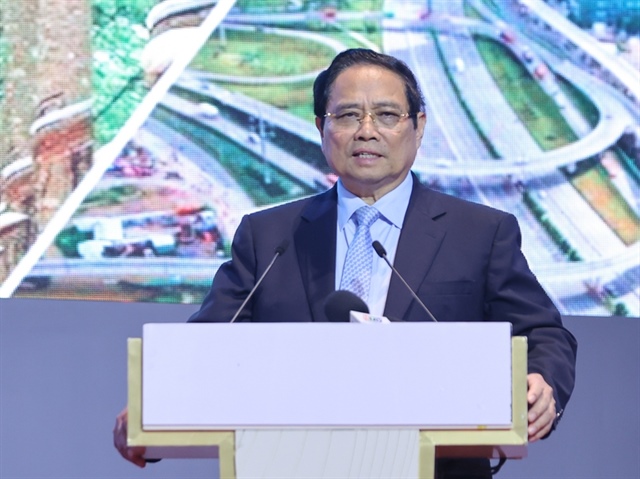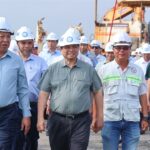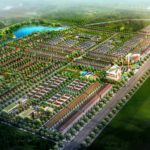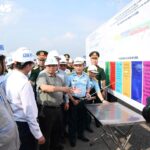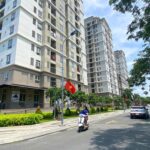|
Prime Minister Pham Minh Chinh chairs the 6th meeting of the Southeastern Region Coordination Council and the 4th meeting of the Steering Committee for the implementation of Resolution No. 98/2023/QH15 of the National Assembly on piloting several special mechanisms and policies for the development of Ho Chi Minh City – Photo: VGP |
At the conference, delegates reviewed the implementation of the goals and tasks of the Southeastern Region Coordination Council since the beginning of 2025, especially after the rearrangement of administrative units from the beginning of July 2025; the situation and results of the implementation of Resolution No. 98/2023/QH15 of the National Assembly after 2 years since its issuance; identifying difficulties, challenges, and bottlenecks, determining their causes, and drawing lessons and issues in the coordination work in the Region after the rearrangement of administrative units, as well as intra-regional and inter-regional coordination and coordination between ministries, sectors, and localities.
Along with that, evaluating the socio-economic situation of Ho Chi Minh City and the Southeastern Region in the first months of 2025; reviewing the progress and promoting key projects of Ho Chi Minh City and the Southeastern Region; determining orientations and focusing on directing the implementation of key tasks, proposing key solutions, and specific tasks for the next period.
The scale of GRDP in the Southeastern Region reaches over 150 billion USD
|
At the conference, delegates reviewed the implementation of the goals and tasks of the Southeastern Region Coordination Council since the beginning of 2025, especially after the rearrangement of administrative units from early July 2025 – Photo: VGP |
According to the reports and opinions at the conference, after the rearrangement of administrative boundaries, the Southeastern Region includes 3 provinces and cities: Ho Chi Minh City (merged with Ba Ria-Vung Tau and Binh Duong), Dong Nai (merged with Binh Phuoc), and Tay Ninh (merged with Long An). The Region holds a particularly important position and serves as the economic hub and a growth pole for the country’s development.
The new Southeastern Region has an area of over 28,000 km2; a population of nearly 21 million; a population density of 749 people/km2; GRDP scale of over 150 billion USD; state budget revenue of over 795 trillion VND (accounting for 36.3% of the whole country); exports of over 135 billion USD (accounting for 33.3%); the number of operating enterprises is over 381,000 (accounting for 41.4%); with nearly 23,000 FDI projects (accounting for 55.4%) with a total investment capital of over 205 billion USD (accounting for nearly 42%).
In the first 6 months of 2025, the GRDP of the Southeastern Region is estimated at 7%. The GRDP scale reached 1,122 trillion VND, ranking first among the economic regions. Total state budget revenue was 431.5 trillion VND, reaching 57.1% of the estimate.
Exports reached 115.7 billion USD, accounting for 31% of the country’s total; import turnover recovered and increased compared to the same period, with the whole region increasing by 11%. Continue to lead the country in the number of projects and total foreign investment capital (nearly 24,000 projects and over 210 billion USD, respectively).
Meanwhile, Ho Chi Minh City (new) was formed on the basis of merging Ho Chi Minh City, Binh Duong, and Ba Ria-Vung Tau, becoming the largest “metropolitan area” in Vietnam. This merger is not just about expanding administrative boundaries, but also about laying the foundation for a new, multi-center, integrated, and sustainable development model, creating a premise for Ho Chi Minh City to become one of the leading developed cities in the region.
The newly merged Ho Chi Minh City has a total area of 6,773 km², accounting for 2.04% of the country’s area; a population of 14 million, accounting for 13.8%; and a labor force of about 7.4 million, corresponding to 13.8%. This large-scale workforce contributes to the promotion of industrial, financial, commercial, and service development.
In terms of economy, Ho Chi Minh City’s GRDP reached about 2,716 trillion VND, equivalent to 113 billion USD, accounting for 23.6% of the country’s GDP. This shows the great economic strength of Ho Chi Minh City and its important role as a growth driver for the national economy.
Ho Chi Minh City is a pioneer in deploying new models for development (such as export processing zones and industrial parks; stock exchanges, banking systems, and investment funds; software parks and high-tech parks…). These innovative models have made important contributions to Ho Chi Minh City’s very strong breakthrough in economic, social development, and international integration.
The GRDP of the city in the first 6 months of 2025 increased by 6.56%. Foreign investment attraction in the first 7 months reached nearly 5 billion USD, up 17.7%. Public investment disbursement reached 55,913 billion VND, equivalent to 47%.
Commercial activities in the city have been expanded in scale; production activities have shown signs of stabilization thanks to trade negotiation prospects, domestic consumption, and market diversification (export turnover in the first 7 months reached 28.51 billion USD, up 10.1%).
Total retail sales of goods and service revenue in the first 7 months of 2025 reached 1.1 trillion VND, up 15.5%. Total tourism revenue reached 140,305 billion VND, up 29.9%, and reached 54% of the yearly plan.
The implementation of the two-level local government has been well organized and is now operating stably and smoothly.
Ensuring social security and taking care of the people’s lives have been given great attention by sectors and levels. Health care and medical services, as well as education, have been given priority in implementation. The development of the digital economy and digital society has been consolidated and strengthened. The work of ensuring social order and safety has been carried out strictly.
Regarding the implementation of Resolution 98, ministries and sectors have completed 8/10 tasks assigned by the Central Government, including the issuance of 4/4 Decrees and 1 Decision of the Prime Minister. Ho Chi Minh City has completed 15/22 tasks and is coordinating the implementation of 7/22 tasks.
The Steering Committee has held 3 meetings and assigned 19 tasks to the central ministries and sectors. Up to now, the ministries and sectors have coordinated and guided Ho Chi Minh City to complete 18/19 tasks.
Resolution No. 98/2023/QH15 stipulates 44 special mechanisms. The city has implemented 36/44 mechanisms, initially achieving positive results; 6/44 mechanisms are being built for implementation, and 2/44 mechanisms have been stopped due to new regulations.
After 2 years of implementing Resolution No. 98 and the Prime Minister’s directions, Ho Chi Minh City has achieved many outstanding results, specifically removing long-standing obstacles (obstacles related to BOT projects); ensuring social security and sustainable poverty reduction (policies for capital allocation for poverty reduction and job creation loans), with the city now having no poor households according to the national poverty line; proactively allocating resources from the city’s budget to implement inter-regional projects and expressways, helping to soon complete investment procedures and accelerate the progress of projects (Ho Chi Minh City – Moc Bai Expressway); mobilizing social resources for development (attracting strategic investors for Can Gio Transit Port and projects following the TOD model).
Regarding limitations and shortcomings, there are still many contents in Resolution No. 98 that need more effort; the progress of building and issuing plans to implement many special mechanisms and policies is slow; some projects have problems that need to be solved…
Developing Ho Chi Minh City to reach regional and world standards
|
Prime Minister Pham Minh Chinh outlined 5 common and key tasks for the coming time – Photo: VGP |
Concluding the conference, Prime Minister Pham Minh Chinh agreed with the reports and opinions presented and assigned the Government Office to coordinate with the Ministry of Finance and the People’s Committees of Ho Chi Minh City, Dong Nai, and Tay Ninh to synthesize the opinions and complete and issue the Conclusion of the conference.
The Prime Minister emphasized that under the direction of the Politburo, the Secretariat, and General Secretary To Lam, we have carried out a revolution in organizational apparatus and rearranged the country’s administrative units, and up to now, we have basically succeeded in turning the situation around and changing the state to step into a new era of development.
On behalf of the Government, the Prime Minister acknowledged and praised the efforts and achievements of the Party committees, authorities, army, and people of Ho Chi Minh City and the Southeastern Region in rearranging the apparatus and administrative units, developing the economy and society, ensuring national defense and security, foreign affairs and international integration, and taking care of the people’s lives, making important contributions to the country’s overall achievements in the first 7 months of 2025.
Outlining 5 common and key tasks for the coming time, the Prime Minister requested, first, based on the functions, tasks, and powers of localities and sectors, to continue reviewing the institutions related to the implementation of Resolution 98 and the development of the Southeastern Region, identifying the contents that need to be supplemented, amended, or abolished, and the Government Office and the Ministry of Finance will synthesize and propose to competent authorities.
Second, the Ministry of Finance, together with localities, will review and update planning to match the rearrangement of provincial-level administrative units and the new socio-economic regionalization orientation, with the spirit of integrating planning based on science, practicality, high feasibility, and creating breakthrough and effective development in line with the country’s development.
Third, organize the mobilization of resources to implement institutions and realize planning, especially promoting public-private cooperation and the participation of the private sector, using state resources to lead and activate all social resources and legal capital sources from home and abroad.
Fourth, the Southeastern Region and localities have new development spaces, conditions, and visions, so they must think big, act big, and train human resources accordingly.
Fifth, governance must be smart and meet the requirements of new development and new organizational spaces, with close links between localities and effective coordination with ministries and sectors.
|
The Prime Minister requested Ho Chi Minh City to continue reviewing, concretizing, and implementing Resolution No. 98/2023/QH15 – Photo: VGP |
Regarding specific tasks for Ho Chi Minh City, the Prime Minister requested to continue reviewing, concretizing, and implementing Resolution No. 98/2023/QH15. Ho Chi Minh City must have higher determination, greater efforts, and more drastic actions, effectively promoting the special mechanisms and policies with a spirit of 05 “leading” aspects.
First, take the lead in digital transformation, the development and application of science and technology, promoting startups, innovation, and the development of a smart city.
Second, take the lead in attracting investment in high-tech industries and green technology associated with sustainable development.
Third, take the lead in developing high-value-added financial, service, and tourism industries and developing the maritime economy.
Fourth, take the lead in developing high-quality human resources and leading experts in key fields.
Fifth, take the lead in implementing social security and welfare policies.
The Prime Minister requested Ho Chi Minh City and ministries and sectors to continue synchronously implementing the contents of Resolution 98, with the spirit of having clear mechanisms, recognizing the need to elevate and mature, and taking more drastic actions, being proactive and creative, and effectively promoting mechanisms for development, affirming that the policies are right, accurate, and suitable for reality and development trends.
The Prime Minister affirmed that the two-level local government apparatus in Ho Chi Minh City must operate stably and smoothly; Ho Chi Minh City sets a target of 8.5% GRDP growth in 2025, with 10.3% in the last 6 months, together with the whole country ensuring a GDP growth rate of 8.3-8.5%; while maintaining macro-economic stability, controlling inflation, ensuring social security and improving people’s lives, ensuring national defense and security, and developing culture, cultural industries, and entertainment industries.
The Prime Minister affirmed that the new space will create new momentum and with its stature, position, vision, and new thinking, Ho Chi Minh City is fully capable of rising with its own hands, brains, land, sky, and sea in a proactive and creative manner, “turning nothing into something, turning difficulties into easiness, and turning impossibilities into possibilities”, reaching regional and world standards.
Regarding the Southeastern Region, the Prime Minister expected and believed that the Region would take the lead in promoting the development of science and technology, innovation, and digital transformation, implementing the 4 resolutions of the Politburo, which are the “four pillars”, and smoothly operating the two-level local government system.
Regarding the direction and tasks of the Southeastern Region Coordination Council in the coming time, the Prime Minister requested to reorganize the Council’s apparatus; study and propose to the Politburo to issue a new Resolution or Conclusion on the development of the Southeastern Region in the era of national prosperity; review, update, and propose mechanisms and policies for the Southeastern Region.
Regarding some key infrastructure projects in the Region, the Prime Minister requested localities to jointly implement them with Ho Chi Minh City, including the successful implementation of the International Financial Center project; striving to start the Ring Road 4 project by August 19; implementing the Can Gio International Transit Port project in the form of public-private partnership; promoting the Long Thanh International Airport project to basically complete in 2025.
For inter-regional connectivity projects such as the Gia Nghia – Chon Thanh Expressway and the Ho Chi Minh City – Moc Bai Expressway, the Ministry of Finance and relevant agencies and localities will review and propose measures to remove obstacles and start construction on August 19, ensuring the progress of implementation.
Along with that, study the Loc Ninh – Bien Hoa railway route connecting Cai Mep and Can Gio ports; study the construction of an underground railway or urban railway connecting Tan Son Nhat and Long Thanh airports.
– 15
Prime Minister’s 8th Inspection: Long Thanh Airport Must Be Fundamentally Completed by December 19, 2025.
On August 2, Prime Minister Pham Minh Chinh visited the construction site of the Long Thanh International Airport in Dong Nai province. He inspected the progress, motivated the workers, and chaired a meeting to accelerate the development of this significant project.
The City of Ho Chi Minh: A New Era of Governance
“With the new two-tier local government structure in place, Ho Chi Minh City has efficiently organized and streamlined its operations. Within a month, the city has successfully appointed and assigned a competent team of officials and civil servants to their respective positions across various departments and units. This marks a significant step forward in the city’s administrative reform, with the establishment of the Public Administration Service Centers at the commune level, aiming to enhance service delivery and improve public accessibility.”
The Prime Minister Inspects Key National Projects in the South
Prime Minister Pham Minh Chinh inspected the site and encouraged the officials, engineers, and workers engaged in the Long Thanh Airport and Nhon Trach Bridge projects, which are part of Ho Chi Minh City’s Belt Road 3.


























